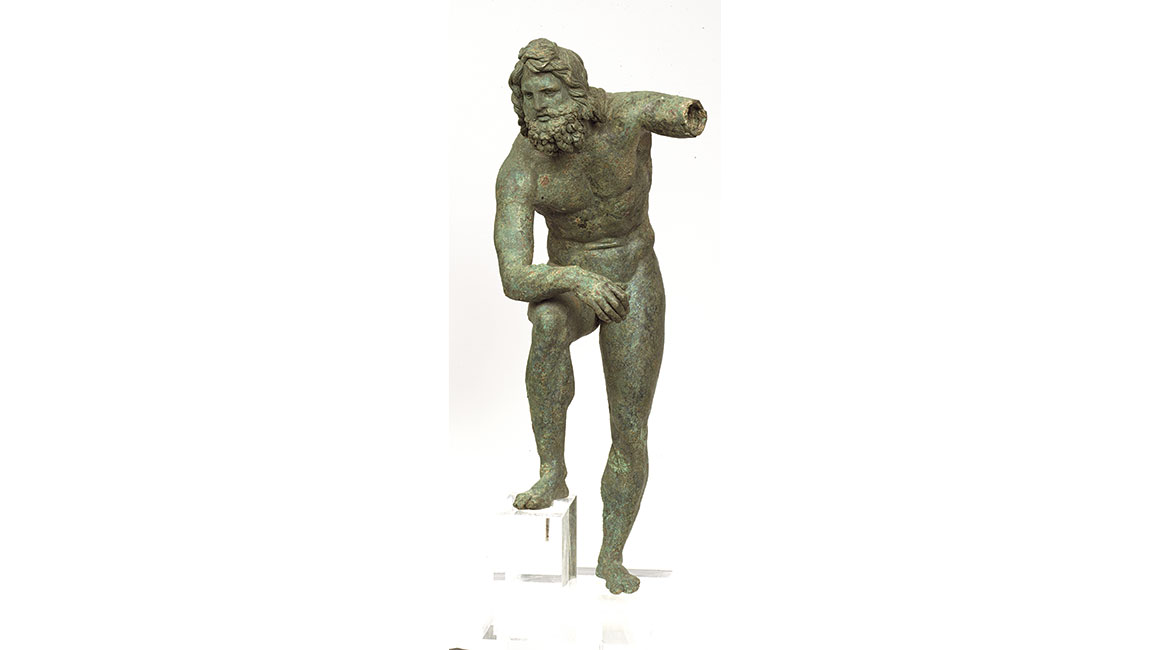Exhibit of the month
Dark-haired Poseidon, help those who voyage in ships …
Χαίρε, Ποσείδαον γαιήοχε, κυανοχαίτα,
καί, μάκαρ, ευμενές ήτορ έχων πλώουσιν άρηγε.
(Hail, Poseidon, Holder of the Earth, dark-haired lord.
O blessed one, be kindly in heart and help those who voyage in ships)
Homeric Hymn to Poseidon, 6-7
Anonymous. The Homeric Hymns and Homerica with an English Translation by Hugh G. Evelyn-White. Homeric Hymns. Cambridge, MA.,Harvard University Press; London, William Heinemann Ltd. 1914.
Statuette of Poseidon
National Archaeological Museum
Metalwork Collection, inv. no X16772
Provenance: Ampelokipoi region, Athens
Dimensions: Height: 0.45 m
Date: 2nd c. AD
Display location: Metalwork Collection, Room 38, Showcase 52
The exquisite cast bronze statuette depicts Poseidon nude reposing. Judging from other similar representations of the god it is presumed that his right foot was stepping on a rock, a dolphin or the prow of a ship, holding most likely the trident in his left hand. His muscular body, in combination with the relaxed pose, emphasizes the magnificence of the god. The rendering of the hair that looks wet, as though he has just emerged from the sea, is an element typical of the god of all waters. As indicated by its size, the statuette probably decorated a villa, whereas it might as well have served as an object for domestic cult or a votive offering.
It is believed that the work constitutes a miniature version of a bronze statue of Poseidon created by the eminent Sikyonian sculptor Lysippos in the 4th c. BC for the Corinthians, to which the sophist Lucian of the 2nd c. AD refers in his Dialogues. A large number of copies and variations of the lost original statue by Lysippos have been preserved that date back to the late Hellenistic and the Roman period. The three-dimensional rendering of the posture of the statuette from Ampelokipoi is revealing of the accomplishment in capturing depth which has been attributed to Lysippos.
Poseidon belongs to the so-called “Ampelokipoi Hoard”[1], namely a group of seventeen bronze statuettes, in a variety of sizes and types, recovered during public works in 1964 in the Athenian neighbourhood of Ampelokipoi. They constitute eclectic imitations of works dating from the 5th and the 4th c. BC, such as the statuettes of Poseidon, and the Discobolos (= Discus -thrower), the depiction of Heracles as Epitrapezios and the statuette conforming to the Doryphoros (=Spear-bearer) type, or replications of Hellenistic themes. The works were possibly stored by their owners under the threat of a raid launched by a barbarian tribe, such as the Heruli (267 AD) or the Goths led by Alaric I (late 4th c. AD). According to a different version a mining workshop operated at the site and the statues were going to be reused as raw material.
Poseidon Kronides (son of Kronos) is one of the most ancient gods of the Greek pantheon. When Poseidon and his brothers Zeus and Hades drew lots in order to determine the realm of each god, he was allotted the dominion of the sea, the rivers, the springs and the lakes. He took residence in two palaces, one on Mount Olympus, together with the other gods, and the second built in the depths of the Aegean Sea, in the Homeric Aiges, where massive waves rose untamed, like goats (= aiges/αἶγες in ancient Greek). There lived together with his spouse, the Nereid Amphitrite. The trident, the dolphin and more rarely the horse and the bull that also denoted his chthonic nature were his symbols.
Poseidon symbolizes the violent forces of nature, as he caused earthquakes, landslides and floods, whereas by brandishing his trident he could raise giant waves or calm down the stormy sea. Odysseus is the most famous recipient of his rage; however the Argonauts were offered his assistance during their arduous expedition. Mariners and sea travellers aimed to gain the god’s favour in their voyages and therefore prayed to him and offered gifts to the numerous sanctuaries that were scattered all over Greece, with the most famous of these being situated at Isthmia in Corinth, Cape Sounion and on the island of Tinos.
[1] The “Ampelokipoi Hoard” as a unit is exhibited in Room 38 of the Metalwork Collection (Showcases 50-52).
Alexandra Chatzipanagiotou
Bibliography (in chronological order):
Φ. Σταυρόπουλος, ΑΔ 20 (1965), Χρονικά Β 1, 103, no 46-2, pl. 59a-b.
G. Daux, “Chroniques des Fouilles 1967”, BCH 92 (1968), 741-743, fig. 16.
Β. Καλλιπολίτης, ΑΔ 23 (1968), Χρονικά Β 1, 10, pl. 5d.
B.S. Ridgway, Roman Copies of Greek Sculpture, Michigan 1984, 68.
Ο. Τζάχου – Αλεξανδρή (ed.), Το Πνεύμα και το Σώμα. Οι αθλητικοί αγώνες στην αρχαία Ελλάδα. Κατάλογος έκθεσης στο Εθνικό Αρχαιολογικό Μουσείο, 15 Μαΐου 1989 – 15 Ιανουαρίου 1990, Αθήνα 1989, 234, cat. no 123 (Π.Γ. Καλλιγάς).
Ε. Bartman, Ancient Sculptural Copies in Miniature Leiden, New York, Koöln 1992, 128-129, no 2, fig. 68.
P. Moreno, Scultura ellenistica I, Roma 1994, 67, fig. 50.
P. Moreno, Lysippο: l’ arte e la fortuna , Milano 1995, 224, 4.33.4.
P. Krystalli – Votsi, “Αteliers toreutiques attiques a l’ epoque romaine”, Acta of the 12th International Congress on Ancient Bronzes: Nijmegen 1992, Nijmegen 1995, 271-281.
LIMC VII (1994), s.v. Poseidon, 453, no 38, pl. 355 (Ε. Simon).
Ν. Καλτσάς (ed.), Αγών, Κατάλογος Έκθεσης Εθνικό Αρχαιολογικό Μουσείο, 15 Ιουλίου – 31 Οκτωβρίου 2004, Αθήνα 2004, 158 cat. no 49 (Ρ. Προσκυνητοπούλου).
H.F. Sharpe, From Hieron and Oikos: the religious and secular use of Hellenistic and Greek Imperial bronze statuettes, Indiana 2006, 119-127, no. 36.
Δ. Τσαγκάρη (ed.), Μύθος και Νόμισμα, Παραστάσεις, Συμβολισμοί και Ερμηνείες από την Ελληνική Μυθολογία, Κατάλογος Έκθεσης στο Εθνικό Αρχαιολογικό Μουσείο και στο Νομισματικό Μουσείο, 15 Απριλίου έως 27 Νοεμβρίου 2011, Αθήνα 2011, 47 cat. no 60 (Π. Μπούγια).
Μ. – Ξ. Γαρέζου et al.(ed.), Ναυτίλος: Ταξιδεύοντας την Ελλάδα, Centre for Fine Arts (Bozar), Βρυξέλλες, 23.01.2014 – 27.04.2014, Αθήνα 2014, 197, cat. no 64 (Ν. Παλαιοκρασσά).
Π. Κρυστάλλη-Βότση, Τα Χαλκά των Αμπελοκήπων, Αθήνα 2014, 87-94.


